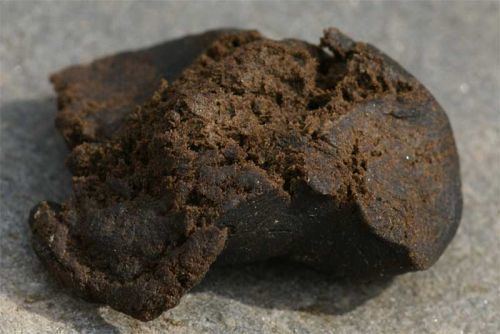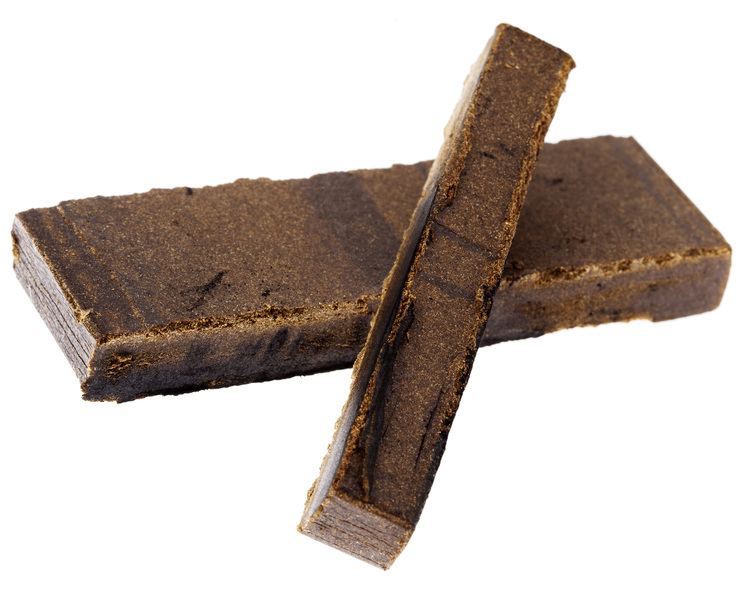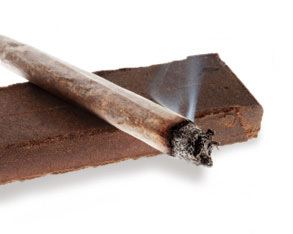Product name Hashish | Part(s) of plant trichome | |
 | ||
Legal status AU: S9 (Prohibited)CA: Schedule IIDE: Anlage I (Controlled)UK: Class BUS: Schedule IUN: Narcotic Schedule I | ||
Hashish, or hash, is a cannabis-family recreational drug that is consumed by Smoking or oral ingestion; typically in a pipe, vaporizer or joints, where it is normally mixed with cannabis or tobacco, as pure hashish will not burn if rolled alone. Hash is an extracted cannabis product composed of compressed or purified preparations of stalked resin glands, called trichomes, from the plant. It contains the same active ingredients as marijuana—such as tetrahydrocannabinol (THC) and other cannabinoids—but often in higher concentrations than the unsifted buds or leaves from which the marijuana is made.
Contents

Hashish may be solid or resinous depending on the preparation; pressed hashish is usually solid, whereas water-purified hashish—often called "bubble melt hash"—is often a paste-like substance with varying hardness and pliability; its color, most commonly light to dark brown, can vary from transparent to yellow, tan, black or red. This all depends on the process and amount of solvent left over.
HASHISH - WikiVidi Documentary
History

The name comes from the Arabic word ( حشيش ) which means grass. It is believed that massive hashish production for international trade originated in Morocco during the 1960s, where the cannabis plant was widely available. Before the coming of the first hippies from the Hippie Hashish Trail, only small pieces of Lebanese hashish were found in Morocco. However, Hemp has been reported from a cultural setting on Taiwan as long ago as 10,000 BC., and "[t]he earliest human use of Cannabis appears to have occurred in the steppe regions of Central Asia or in China."

Northern India has a long social tradition in the production of hashish, known locally as charas, which is believed to be the same plant resin as was burned in the ceremonial booz rooz of Ancient Persia. Cannabis indica grows wild almost everywhere on the Indian sub-continent, and special strains have been particularly cultivated for production of ganja and hashish, especially in West Bengal, Rajasthan and the Himalayas.

In 1596, Dutchman Jan Huyghen van Linschoten spent three pages on "Bangue" (bhang) in his historic work documenting his journeys in the East. He particularly mentioned the Egyptian Hashish. He said, "Bangue is likewise much used in Turkie and Egypt, and is made in three sorts, having also three names. The first by the Egyptians is called Assis (Hashish (Arab.)), which is the poulder of Hemp, or of Hemp leaves, which is water made in paste or dough, they would eat five peeces, (each) as big as a Chestnut (or larger); This is used by the common people, because it is of a small price, and it is no wonder, that such vertue proceedeth from the Hempe, for that according to Galens opinion, Hempe excessively filleth the head."
In the 1800s, hashish was embraced in some European literary circles. Most famously, the Club des Hashischins was a Parisian club dedicated to the Consumption of hashish and other drugs; its members included literary luminaries such as Théophile Gautier Dr. Moreau 'de Tours, Victor Hugo, Alexandre Dumas, Charles Baudelaire and Honoré de Balzac. Baudelaire later wrote the 1860 book Les paradis artificiels, about the state of being under the influence of opium and hashish. At around the same time, American author Fitz Hugh Ludlow wrote the 1857 book The Hasheesh Eater about his youthful experiences, both positive and negative, with the drug.
Use
Hashish can be consumed by oral ingestion or smoking; typically in a pipe, vaporizer or joints, where it is normally mixed with cannabis or tobacco, as pure hashish will burn poorly if burned alone.
Hashish is made from cannabinoid-rich glandular hairs known as trichomes, as well as varying amounts of cannabis flower and leaf fragments. The flowers of a mature female plant contain the most trichomes, though trichomes are also found on other parts of the plant. Certain strains of cannabis are cultivated specifically for their ability to produce large amounts of trichomes. The resin reservoirs of the trichomes, sometimes erroneously called pollen (vendors often use the euphemism "pollen catchers" to describe screened kief-grinders in order to skirt paraphernalia-selling laws), are separated from the plant through various methods.
Mechanical separation methods use physical action to remove the trichomes from the plant, such as sieving through a screen by hand or in motorized tumblers. This technique is known as "drysifting". The resulting powder, referred to as "Kief" or "drysift", is compressed with the aid of heat into blocks of hashish; if pure, the kief will become gooey and pliable. When a high level of pure THC is present, the end product will be almost transparent and will start to melt at the point of human contact.
Ice-water separation is another mechanical method of isolating trichomes. Newer techniques have been developed such as heat and pressure separations, static-electricity sieving or acoustical dry sieving.
Trichomes may break away from supporting stalks and leaves when plant material becomes brittle at low temperatures. After plant material has been agitated in an icy slush, separated trichomes are often dense enough to sink to the bottom of the ice-water mixture following agitation, while lighter pieces of leaves and stems tend to float.
The ice-water method requires ice, water, agitation, filtration bags with various-sized screens and plant material. With the ice-water extraction method the resin becomes hard and brittle and can easily be separated. This allows large quantities of pure resins to be extracted in a very clean process without the use of solvents, making for a more purified hashish.
Chemical separation methods generally use a solvent such as ethanol, butane or hexane to dissolve the lipophilic desirable resin. Remaining plant materials are filtered out of the solution and sent to the compost. The solvent is then evaporated, or boiled off (purged) leaving behind the desirable resins, called honey oil, "hash oil", or just "oil". Honey oil still contains waxes and essential oils and can be further purified by vacuum distillation to yield "red oil". The product of chemical separations is more commonly referred to as "honey oil." This oil is not really hashish, as the latter name covers trichomes that are extracted by sieving. This leaves most of the glands intact.
In a study conducted in 2014 by Jean-Jaques Filippi, Marie Marchini, Céline Charvoz, Laurence Dujourdy and Nicolas Baldovini (Multidimensional analysis of cannabis volatile constituents: Identification of 5,5-dimethyl-1-vinylbicyclo[2.1.1]hexane as a volatile marker of hashish, the resin of Cannabis sativa L.) the researchers linked the characteristic flavour of hashish with a rearrangement of myrcene caused during the process of manufacture.
The largest producer is Afghanistan.
Quality
Tiny pieces of leaf matter may be accidentally or even purposely added; adulterants introduced when the hashish is being produced will reduce the purity of the material and often resulting in green finished product. The tetrahydrocannabinol (THC) content of hashish comes in wide ranges from almost none to 65% and that of hash oil from 30% to 90%.
